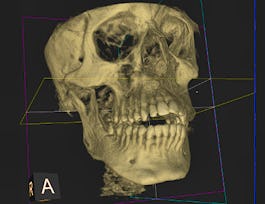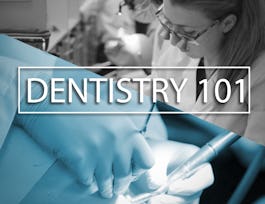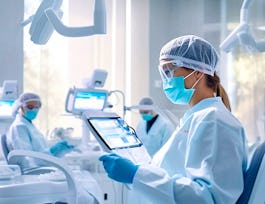In this course, Frontiers in Dentistry, you will be able to explore some of the latest advances in the field of dental medicine. The innovations in therapeutic techniques as well as our understanding of the biomedical sciences have been made possible by our research enterprise which integrates the latest emerging technology along with interdisciplinary collaborations.

Schenken Sie Ihrer Karriere Coursera Plus mit einem Rabatt von $160 , der jährlich abgerechnet wird. Sparen Sie heute.


Frontiers in Dentistry
Dieser Kurs ist Teil von Spezialisierung The Integration of Art and Science in Modern Dental Medicine

Dozent: Dr. Uri Hangorsky
2.850 bereits angemeldet
Bei  enthalten
enthalten
(32 Bewertungen)
Empfohlene Erfahrung
Was Sie lernen werden
You will learn about five evolving domains of dentistry and how it addresses the clinical needs of the population.
You will learn about the varying therapeutic and scientific innovations that have been incorporated into each practice and how they benefit patients.
You will learn about the various technology advancements that have enabled these dental domains to develop.
Kompetenzen, die Sie erwerben
- Kategorie: Artificial Intelligience
- Kategorie: Dentistry
- Kategorie: Inclusive Care
- Kategorie: Dental Technologies
Wichtige Details

Zu Ihrem LinkedIn-Profil hinzufügen
5 Aufgaben
Erfahren Sie, wie Mitarbeiter führender Unternehmen gefragte Kompetenzen erwerben.

Erweitern Sie Ihre Fachkenntnisse
- Lernen Sie neue Konzepte von Branchenexperten
- Gewinnen Sie ein Grundverständnis bestimmter Themen oder Tools
- Erwerben Sie berufsrelevante Kompetenzen durch praktische Projekte
- Erwerben Sie ein Berufszertifikat zur Vorlage


Erwerben Sie ein Karrierezertifikat.
Fügen Sie diese Qualifikation zur Ihrem LinkedIn-Profil oder Ihrem Lebenslauf hinzu.
Teilen Sie es in den sozialen Medien und in Ihrer Leistungsbeurteilung.

In diesem Kurs gibt es 6 Module
Throughout this course, you will be provided the opportunity to explore some of the latest, most fascinating advances in dental medicine. These innovations in therapeutic techniques as well as our understanding of the biomedical sciences have been made possible by our research enterprise which integrates the latest emerging technology along with interdisciplinary collaborations. We will begin the course with a warm welcome from Penn Dental Medicine's Morton Amsterdam Dean, Dr. Mark Wolff, and a brief introduction to the five domains that we will be discussing in this course. You will also get the opportunity to tell us more about yourself and your hopes for this learning experience. Let's get started!
Das ist alles enthalten
1 Video2 Lektüren1 Diskussionsthema
The University of Pennsylvania provides a unique sense of collaboration that fosters cross-discipline partnerships. The Center for Innovation & Precision Dentistry (CiPD) is a vibrant community of experts in Penn Dental Medicine and Penn’s School of Engineering and Applied Sciences who leverage cutting-edge yet affordable approaches. The CiPD allows for accelerated discovery and translation of new therapies, diagnostics, and devices to address unmet needs in oral health. The CiPD also trains the next generation of leaders in dental, oral, and craniofacial research, and oral healthcare innovation. Several completed and in-progress projects will be highlighted in this week's module in an interview with Dr. Michel Koo, a Professor at the School of Dental Medicine and the co-Director of the Center for Innovation & Precision Dentistry (CiPD) at the University of Pennsylvania.
Das ist alles enthalten
1 Video2 Lektüren1 Aufgabe
For the 61 million Americans who have disabilities, going to the dentist can be a harrowing experience. There are many things to consider, including accessibility, finding care, and geographic proximity. Patients with hearing impediments, cognitive impairments, physical challenges, age, or disease-related difficulties need dentists, along with spaces designed for them and their caregivers. Mainstream healthcare providers are not often taught how to take different disabilities into consideration in their practices and treatment planning, which impacts millions of Americans’ access to healthcare every year. Minimally invasive care techniques that might not be typically considered in treatment planning are strong tools when treating patients whose disabilities might prevent them from receiving traditional treatment techniques. The Penn Dental Care Center for Persons with Disabilities is a unique opportunity for both patients and providers. It gives patients a tailored experience, taking into consideration a multitude of accessibility concerns. Students are given direct experience in treating patients with alternative needs as well as a good example of what accessibility looks like when considering their futures beyond Penn Dental Medicine. The ability of academic institutions to train the next generation of dentists who will be capable of treating patients with disabilities while also being cognizant of the various attitudinal, physical, and financial barriers is one of the formidable challenges facing the dental profession. To discuss these and other related issues we have invited one of the experts in this area, Dr. Miriam Robbins.
Das ist alles enthalten
3 Videos3 Lektüren1 Aufgabe
This module will discuss the up-to-date clinical and laboratory biomaterials research, focusing on esthetic dentistry, minimally invasive and adhesive dentistry, implant prosthodontics, novel materials, and modern CAD/CAM technologies. Which have improved our diagnostic capabilities and clinical outcomes. Combining advances in adhesive dental materials with advances in digital technologies, such as AI, provides a less invasive and more aesthetic outcome for the patient. These advances make calibration and communication between providers and specialties easier and more cost-effective. As the technology advances, dental professionals can provide more tailored and precise treatment to more patients at a lower cost and in fewer steps. We have invited an expert in this field, Dr. Markus Blatz, to provide more information about this domain.
Das ist alles enthalten
1 Video2 Lektüren1 Aufgabe
This module delves deeper into the advances of Computer-Aided Design and Computer-Aided Manufacturing (CAD/CAM) technologies and artificial intelligence. One of the most exciting frontiers and innovations in dentistry has been the recent incorporation of computer-controlled components in patients’ diagnostic and clinical procedures. This computer-controlled approach to dental therapeutics is widely known as digital dentistry and it has the potential to increase both the efficiency and effectiveness of clinical treatment resulting in better clinical outcomes. CAD/CAM technology has been around for several decades but has advanced significantly during that time with the addition of artificial intelligence. AI has enabled CAD/CAM technology to extend into the realm of diagnostics, and software is now able to identify potential risk factors in patients. In addition, intraoral scans provide a digital clone of the patient, allowing for better treatment planning and visual communication with the patient and in fewer appointments. These methods also reduce the number of materials required to treat the patient and are more precise than traditional fabrication methods. This technology has become less expensive over time, making this less invasive technology more accessible to a great number of patients. To explain this fascinating area in dentistry is Dr. Conejo who is the Clinical CAD/CAM Director at the Department of Preventive and Restorative Sciences
Das ist alles enthalten
1 Video3 Lektüren1 Aufgabe
Orthodontics is the dental specialty dealing with the correction of irregularities of the teeth, such as malocclusion, often by the use of braces. This treatment aims to ensure the proper form and function of the dentition. Like many other medical entities, orthodontic therapy has been undergoing significant changes influenced by the rapidly emerging technology, one of which is the exciting field of clear aligner therapy. In orthodontics, the computer-based three-dimensional image, which shows the current status of teeth and consequently enables a detailed and precise photorealistic 3D model, is indeed a basis for an innovative approach to treatment. This approach has the possibility of making orthodontic therapy available to millions of individuals who have otherwise been unable to afford orthodontic care. We have invited Dr. Sam Kadan to discuss this newly emerging area.
Das ist alles enthalten
1 Video2 Lektüren1 Aufgabe
Dozent

Empfohlen, wenn Sie sich für Patient Care interessieren

University of Pennsylvania

University of Michigan

University of Pittsburgh

University of Pennsylvania
Warum entscheiden sich Menschen für Coursera für ihre Karriere?




Bewertungen von Lernenden
Zeigt 3 von 32
32 Bewertungen
- 5 stars
90,62 %
- 4 stars
6,25 %
- 3 stars
3,12 %
- 2 stars
0 %
- 1 star
0 %
Geprüft am 8. Sep. 2023
Geprüft am 30. Juli 2023
Geprüft am 10. Aug. 2023

Neue Karrieremöglichkeiten mit Coursera Plus
Unbegrenzter Zugang zu über 7.000 erstklassigen Kursen, praktischen Projekten und Zertifikatsprogrammen, die Sie auf den Beruf vorbereiten – alles in Ihrem Abonnement enthalten
Bringen Sie Ihre Karriere mit einem Online-Abschluss voran.
Erwerben Sie einen Abschluss von erstklassigen Universitäten – 100 % online
Schließen Sie sich mehr als 3.400 Unternehmen in aller Welt an, die sich für Coursera for Business entschieden haben.
Schulen Sie Ihre Mitarbeiter*innen, um sich in der digitalen Wirtschaft zu behaupten.
Häufig gestellte Fragen
Access to lectures and assignments depends on your type of enrollment. If you take a course in audit mode, you will be able to see most course materials for free. To access graded assignments and to earn a Certificate, you will need to purchase the Certificate experience, during or after your audit. If you don't see the audit option:
The course may not offer an audit option. You can try a Free Trial instead, or apply for Financial Aid.
The course may offer 'Full Course, No Certificate' instead. This option lets you see all course materials, submit required assessments, and get a final grade. This also means that you will not be able to purchase a Certificate experience.
When you enroll in the course, you get access to all of the courses in the Specialization, and you earn a certificate when you complete the work. Your electronic Certificate will be added to your Accomplishments page - from there, you can print your Certificate or add it to your LinkedIn profile. If you only want to read and view the course content, you can audit the course for free.
If you subscribed, you get a 7-day free trial during which you can cancel at no penalty. After that, we don’t give refunds, but you can cancel your subscription at any time. See our full refund policy.

